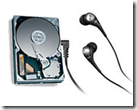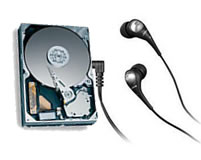
How To Tell If The Noisy Hard Drive Is Normal?
 Current hard drive technology dictates that some noise will occur during drive operation. The type of noise and the volume of the noise can change depending on the current function that the drive is involved in. It is important to recognize which noises indicate trouble and which are simply normal drive sounds.
Current hard drive technology dictates that some noise will occur during drive operation. The type of noise and the volume of the noise can change depending on the current function that the drive is involved in. It is important to recognize which noises indicate trouble and which are simply normal drive sounds.
Normal drive sounds include:
- Whining noise during drive spin-up
- Occasional clicks during data access
- Hard clicks during a head park operation (shutdown or sleep mode)
Abnormal drive sounds include:
- High-pitched whining sound
- Vibration sounds due to either vibration in the mounting hardware or in rare cases, a drive failure
- Clicking or clunking sounds that occur repeatedly
- Grinding sounds
Solutions:
Step1: Make sure it is not a case fan or another device
Turn off the system. Remove both the power and data cables from the drive. Turn on the system to see if the noise continues. If the noise is still present, the drive is not the cause. Search for another device such as a case fan, which is causing the noise. If the noise is no longer present, continue with Step 2.
Step 2: Determine if the problem is the hard drive or its data cable
Turn off the system. Connect only the power cable to the drive, and turn on the system. If the noise occurs, the problem is with the drive. At this point, continue with Step 3. If the there is no noise, the drive is not at fault. Turn off the system and connect your data cable. Turn on the system. If the noise occurs now, your data cable is faulty and should be replaced.
Step 3: Try the hard drive in a new location
Turn off the system. Install the drive into a different drive bay or place it securely on an anti-static surface if available. Attach only the power cable. Turn on the system. If the noise is still present, the drive has failed and should be replaced.


 Have you ever heared a clicking noise from your hard drive? Do you want to know how to diagnose and recover your hard drive from this noise? Recently i found a professional recovery company (DataCent.com) which is good at recoverying data from thses hard drive clicks such as bellows:
Have you ever heared a clicking noise from your hard drive? Do you want to know how to diagnose and recover your hard drive from this noise? Recently i found a professional recovery company (DataCent.com) which is good at recoverying data from thses hard drive clicks such as bellows: